
A few weeks ago, I wrote a post titled, “Metrosexual Murdabad!” Although I gained the ire of some commenters, I think amongst the Langar-ites, the ‘metrosexual’ trend is not the preference.
Waris Ahluwalia, of Inside Man fame and a sort of favorite in The Langar Hall — see here and here — made the following comments: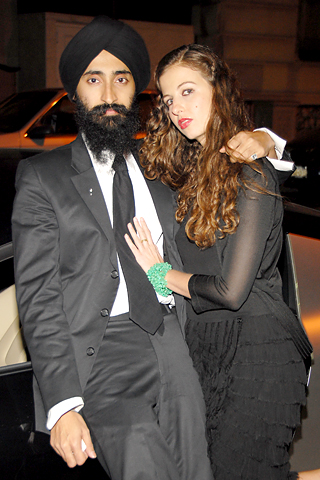
Waris Ahluwalia has been wearing makeup for about ten years, he told us last night at Chanel’s Tribeca Film Festival Party at the Greenwich Hotel. “I’m only telling you this because it’s New York Magazine, but I’m actually 68,” he quipped (he’s not, he’s in his thirties). We asked if his friends would be into man makeup, like Jean Paul Gaultier‘s new male cosmetics line, Monsieur. “No, no. I stopped hanging out with the theater group a long time ago,” he said. Oh, har! Ahluwalia also shuns the men-in-tight-pants trend. “I love trends,” he said. “Doesn’t mean I have to follow it.” Other trends Ahluwalia dislikes include the overusage of words like “bespoke” and “luxury.” “Everyone just calls things that. Bespoke olive oil?” he said. “I saw an ad in Wired for the new Acura. That ad was four lines, and they said ‘luxury’ fives times.” [link]
While bespeaking for Waris’ and our readers’ patience may be a luxury I can ill-afford as I write this sentence, still I am pleased that our turbaned Sikh Mr. Waris Ahluwalia seconds my thoughts on the ‘metrosexual’ trend. (Ok there really wasn’t a purpose for that last sentence other than I was looking to use ‘bespoke’ (or ‘bespeak’ in the present) and ‘luxury’ in the same line. Happy Monday!
I have mentioned Bant Singh before in a previous post, but yesterday while scouring through Youtube I came across a great video of him, his message, and his voice.

To those that may not have heard of him, Bant Singh is from a so-called lower caste background from Pind Jabhar in Zilla Mansa in Punjab. He emerged as a labor activist and became a lead figure in the Mazdoor Mukti Morcha (Laborer’s Liberation Movement).
Although in the blogosphere, I was beaten again by Shinda’s blog, I did want to highlight it again here at TLH.
The Toronto Star reported today that “Brampton bridegroom murdered in Punjab.” Although the tragedy is fresh, the Toronto Star is putting together the story as follows.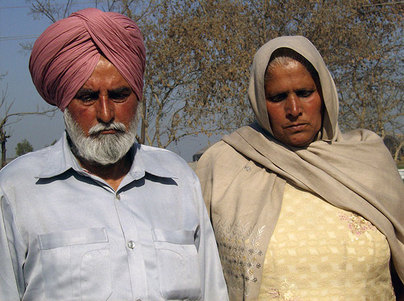
One Jasvir Singh Dhaliwal had been dating a girl, Amandeep Gill for four years. Recently he decided to break off their relationship and marry a woman from Punjab. At the pre-wedding celebrations in his native village, a car came and committed a drive-by shooting killing Jasvir and one of his cousins.
The Punjab Police have moved to bring charges against Amandeep’s Punjab-based parents and even have submitted extradition procedures to the Canadian government for questioning about the case.
Never too far from the scene, a crooked Punjab Policemen has also appeared:
Ashwini Kumar, a police constable with the Indian Reserve Battalion, has been charged with first-degree murder in the case. [link]
I have commented on this topic before, but, unfortunately, I am sure more and more new cases will continue to pop up.
At the vanguard of civil rights, the California Supreme Court affirmed the right to gay marriage today by overturning two of the state’s previous bans. The legislative debate over “gay marriage” (now, simply marriage) began in California in 2004, when San Francisco mayor Gavin Newsom ordered the county clerk to issue marriage licenses to same-sex couples.

Already opponents of the decision have thrown down the gauntlet, saying that they will push to place a constitutional amendment on the ballot to ban gay marriage. I say bring it on — I hope that people vote down such an obvious attempt to abrogate a decision that, at its core, is based on principles of equality. And then, I hope they gather signatures and pass a constitutional amendment UPHOLDING marriage equality, just to make it perfectly clear that voters are willing to be proactive on this issue.
I’ve made my position clear, but I have to say that I am incredibly proud and honored to be a Californian today. I remember wondering if marriage equality was something I would ever see in my own lifetime, or if it would be delayed for generations to come.
I just wanted to remind all of you out there, particularly those who live in California, that you can still sign up for the annual Jakara Sikh Youth Conference. The conference is in Fresno, California on the Fresno State campus and the dates for this year are June 19-22, 2008. Don’t be lazy, register and avoid a late fee.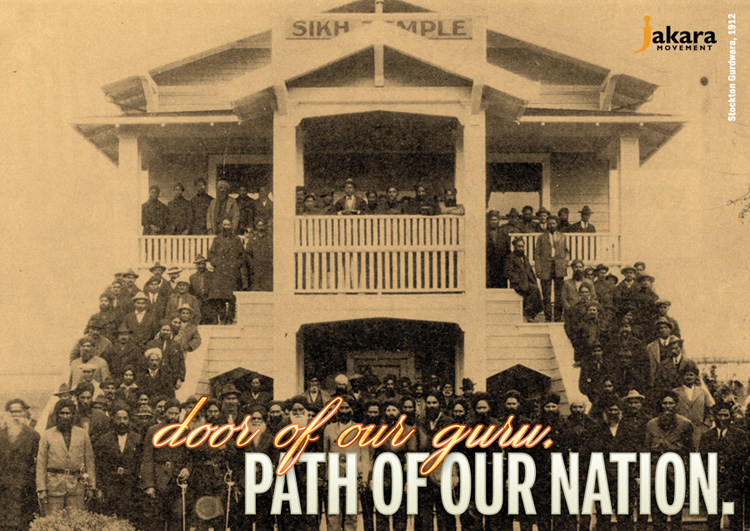
This year’s theme is “Growing with Our Gurdwara.” The introduction from the website are as follows:
They don’t speak our language. They have too much politics.
They are too corrupt.Too few young Sikhs are found at their local Gurdwaras. While young children play outside after Punjabi School and our parents congregate in the langar hall, too many Sikh youth decide not to go to Gurdwara.
However, this does not mean our spiritual thirst has been quenched. It is time for a change. It is time to stop blaming others. It is time for the next generation of Sikhs to empower ourselves and engage with our Gurdwaras. It is time to turn the “they” and “them” into “we” and “us”. The Gurdwara is OUR institution; it will always be the center of Sikh life. It is OUR grassroots democracy if we make it so.
This year at the Jakara Movement Sikh Youth Conference 2008, we will re-create, re-engage, re-emerge with the “door to our Guru”. Join us as we re-kindle our center and grow with our Gurdwara. [link]
India is shining yet again…
In Chhattisgarh, May 14th, 2008 marks the one year anniversary of Dr. Binayak Sen’s incarceration. The arbitrary arrests we remember from Punjab in the 80s and early 90s have continued in other areas of India like Chhattisgarh.
The renowned public-spirited paediatrician Dr. Binayak Sen is General Secretary, People’s Union
for Civil Liberties (“PUCL”), Chhattisgarh and Vice-President, National PUCL. He was arrested May 14th, 2007, under the provisions of the Black Laws (The Chhattisgarh Special Public Security Act [CSPSA], 2005, and the Unlawful Activities [Prevention] Act, 1967 as amended in 2004). The CSPSA, a creation of the Manmohan Singh regime, provides for arbitrary detention backed by an “ouster of jurisdiction” clause providing that action under the “Act by any officer authorized by the government for this purpose or by the District Magistrate shall not be questioned before any court.” The charges are farcical: meetings with Narayan Sanyal, an imprisoned leader of the Communist Party of India (Maoist) that took place in jail and in the presence of a jailer.
Sen is well known and highly respected for his work with tribal populations in Chhatisgarh.
Sen is famous for drawing up one of the most successful community-based primary healthcare schemes in India, based on the Mitanin, the local barefoot health worker who gives the rural poor invaluable advice on preventative health.
LATEST DEVELOPMENT: The Sikh Coalition, from initial press reports although not found on their website, seems to be demanding the perpetrator Garret Green should be charged as committing a hate crime.
Harsimran Kaur, staff attorney of Sikh Coalition, told IANS the school has told them that they have taken the harshest measures against the student who committed the atrocious act.
“But I am disappointed with the slow police response. The incident took place last Monday, and they interviewed the victim only Friday. They have also not taken us into confidence on the investigation,” Kaur said.[link]
The school district has objected to the label, citing the following:
Mr. Bolandi said one of the reasons district officials do not believe the incident was hate-related is that Mr. Green made no comments to the victim.
”There was no discussion at all,” he said. “The victim didn’t even know who did it. It took us an hour to figure that out, and eventually he admitted it.”
Mr. Bolandi added that Mr. Green has had previous discipline issues in school. [link]
For those of you that may have missed The Daily Show last night, you missed a brilliant scene of actual journalism. While others claim a ‘no spin zone,’ here is Jon Stewart at his best in maintaining a respectful tenor, but never allowing former Under Secretary of Defense and now Professor at Georgetown University, Douglas Feith, to dodge the important questions. Few are adept as Stewart at using Feith’s logic against him.
Sad is the state of democracy in America that we look to the “fake news” hosted by comedians for real interviews and questions, while on the “real news” we only get tabloid droll, consisting of smears about supposed terrorist endorsements, worries about former pastors, and who knows what else is of little to no importance.
If you are interested in the lead up to the war in Iraq (and I hope every American is), then these 15 minutes are well-worth the watch. Would love to hear your comments and reaction.
Part 2 of the interview
Another university endowment has been gifted. This time it goes to the School of Advanced International Studies of Johns Hopkins (SAIS) for “India studies,” and comes from Mohinder P. Sambhi, a Ludhiana-born hypertension specialist.
A prominent Indian-American has donated $2 million to establish an endowment for India studies at Johns Hopkins University’s School of Advanced International Studies. The endowment is the first of its kind in Washington…The fund supports student fellowships, a professional lecturer and eventually a professorship to be held by a scholar or practitioner whose eminence and promise in the field deepens Indian scholarship and instruction at SAIS, the institution says.
SAIS is reknown for its programs in international affairs. In the past, it was also reknown for its neo-conservative tilt, home to faculty members such as Francis Fukuyama who was an important figure in the rise of neo-conservatism and a key contributor to the Reagan doctrine of containment. As the Iraq debacle has unfolded in recent years, Fukuyama has backed away from the neo-conservative agenda.
So it seems the Democratic nominee may finally be set. After what a most astute commentator has called “The LONG FLAT SEEMINGLY ENDLESS BATAAN DEATH MARCH to THE WHITE HOUSE,” the end is finally within sight. It seems that Obama has numerically emerged the victor.
Members of this blog have been very active in campaigning for Senator Obama. I am sure they are pleased.
However, within our community, I believe a false dichotomy has often been presented. Some have stated that while many young Sikhs have been far more engaged with the Obama campaign, older members of our community have fundraised for the Clinton campaign. I believe that this age-difference distinction has always been grossly exaggerated.
Using Occam’s razor, a simpler thesis may suffice. While Hillary Clinton was the favorite at the beginning of the campaign, as the winds changed others were slower to jump on Obama’s bandwagon. I am sure we will see many ‘older’ Sikhs fundraising for Obama as we get nearer to the fall.
In fact, here is one voice that defies such characterization. Here is one Punjabi poet’s dedication to Obama (yes Phulkari, you get subtitles too!).
The Sikh Coalition was informed of Kamal Nath’s visit to speak at Northwestern‘s Kellogg School of Management tomorrow. There is a petition circulating for those of us deeply concerned about a Human Rights violator being hosted by Northwestern University. To have your voice heard, please click here and fill out the petition.
Thanks Anandica — just to add what are his offenses:
Kamal Nath, a Congress official close to the Gandhi family, helped lead a mob towards Gurdwara Rakab Ganj during the Delhi 1984 anti-Sikh pograms. He was present as a number of Sikhs were torched alive and was outside as the crowd pelted the Gurdwara, attempted to burn it, and massacre those that sought refuge inside. He has denied all allegations and numerous tribunals, although failing to convict him (or ANYONE for that matter) have all had serious questions about his alibi. [Jodha]
Those in Punjab who don’t have access to hospitals and licensed doctors often seek cures from quacks posing as medicine men and the plethora of cure-all medication sold by hawkers at bus stops. In central California too, illegal immigrants turn to traditional healers.
Immigrants interviewed amid the vineyards of Madera and the cantaloupe fields of Mendota said they had faced numerous obstacles to pursuing conventional medical care. Above all, they said, was cost, but other factors included fear of deportation, long waits for treatment in medically underserved areas, and barriers of culture and language.
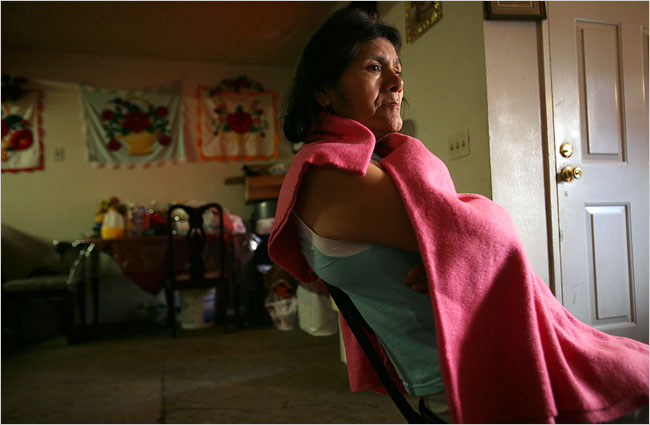 This article focuses on the Hispanic immigrant community, but the issue it raises applies to Punjabi Sikh legal and illegal immigrants as well. I would venture that some Punjabi immigrants (legal or illegal), because of the high cost of American health care, would prefer the care of a member of the community with questionable credentials to an emergency room of seemingly hostile nurses and doctors. We’ve mentioned many homeopathic medicines that many people find to be great for preventative and healing purposes. But there is a risk to traditional medicines too- that patients who may have serious illnesses will postpone diagnosis, aggravating an illness that could have been more easily addressed if diagnosed earlier.
This article focuses on the Hispanic immigrant community, but the issue it raises applies to Punjabi Sikh legal and illegal immigrants as well. I would venture that some Punjabi immigrants (legal or illegal), because of the high cost of American health care, would prefer the care of a member of the community with questionable credentials to an emergency room of seemingly hostile nurses and doctors. We’ve mentioned many homeopathic medicines that many people find to be great for preventative and healing purposes. But there is a risk to traditional medicines too- that patients who may have serious illnesses will postpone diagnosis, aggravating an illness that could have been more easily addressed if diagnosed earlier.
The situation may sound familiar to many Sikhs. Government forces practiced storming a religious center by creating a mock model. No, I am not talking about the Government of India in 1984 *[see bottom], but rather the American Government in 2008.
Last week, a number of US government agencies ran a drill to practice their emergency preparation. A newspaper reported:
For the purpose of Thursday night’s emergency exercise drill, the Continuing Recovery Center in Irving had become Irving Mosque, the home-base for a radical, heavily armed group with suspected terrorist ties.
There were explosions outside and inside the building. Illinois Law Enforcement Alarm System (ILEAS) special forces stormed the “mosque” from an armored car. [link]
Members of the Muslim community, I believe, rightfully protested the implications:
The use of a fake ‘mosque’ in this type of drill sends the wrong message to law enforcement officials who may now view mainstream institutions, such as Islamic houses of worship, as potential security threats,” said Ahmed Rehab, executive director of CAIR’s Chicago chapter (CAIR-Chicago). “Officials must be trained in dealing with hostage-taking and responding to chemical, biological or bomb attacks. We are only questioning the wisdom of linking the American Muslim community and its institutions to such incidents.” [link]
Those that join the teaching profession tend to be do-gooders. I recently came upon a Houston (Canada, not Texas!) teacher, Carroll Airey.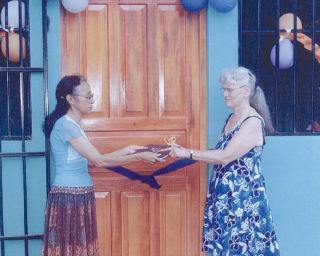
Carroll Airey is making a difference.
Airey, a retired Twain Sullivan teacher-librarian, has been fundraising for a town in Nicaragua — Santa Rosa del Penon — for almost 10 years.
Airey’s reach into Central American began in 1998 after Hurricane Mitch tore through the country. Airey set up the Children Helping Children club at Twain Sullivan and the group managed to raise $10,000 that helped out two communities: Santa Rosa del Penon and El Bosque. [link]
The article describes some of Carroll’s exceptional work. Through the sales of Fair Trade organic coffee, tea, and chocolate she has helped support a maternity clinic, nutrition program, garden project, and a sewing school. Recently, while in Nicaragua, she has begun efforts to house a library and a small computer center. Googling her on the internet, I found that she has also initiated a global arts exchange program between children in Houston (Canada, not Texas!) and Santa Rosa del Penon (Nicaragua).
Other bloggers have discussed their convictions regarding manly men, but Dalip Singh Rana from Himachal Pradesh may have taken this concept to a whole new level.

At a mere 7 feet, 3 inches and 420 pounds, Dalip Singh is blazing a new trail into World Wrestling Entertainment.
He is the first Indian to be signed up by WWE, and enjoys top billing in the famous American showbiz circus alongside fighters such as Hulk Hogan and The Rock.
The WWE website says of Rana:
This enormous monster has walked the jungles of India unafraid of pythons and wrestled White Bengal tigers. Legend states that the Punjabi Warrior has “stared into the abyss and the earth trembled at his gaze.
A Non-Sikh friend of mine recently asked me about the naming conventions in the Sikh religion. She was wondering why “deep” and “jit” were so common at the end of Sikh names, and did this take away from a person’s individuality. (Like Joe Smith?) I thought it was an interesting point, but personally I don’t feel my name defines me. My uniqueness comes from my personality, the pursuit of my own path and growing through my experiences. Although I do feel I have grown into my name, and it does hold significance for who I am becoming as a human being. What is amazing about our names is the depth of their meanings, the interchangability of parts of the names to create a new meaning, and that they are epicene names. When I do tell Non-Sikhs what my name means, the response is always “Wow, that is so cool!”.
A new pattern emerging these days is the shortening of the name and/or being creative with the way it is spelt. It is inevitable changes will happen as we assimilate to the western world we live in, and with the generational changes that are happening. People used to put faith with the Guru Granth Sahib and the first letter that was chosen, at random, became the starting point for naming a new baby. Is this a tradition that is being utilized today?
We have such an immense choice of names, and I have yet to find a culture that holds deeper meanings for their names, however common they may be, than ours.
I pose this question to you all: What does your name mean to you?
Our phones have become an extension of our bodies. Walk around outside and you’ll see the dawn of the blue-tooth era with the masses walking and having conversations with everybody, but the people that are actually physically near them. Seeking to capitalize on the trend, phone companies seem to sell us everything but the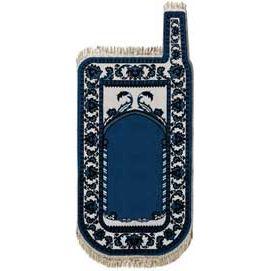 actual plan. You can buy wallpapers, ringtones, and other superfluous things to ‘pimp your phone.’
actual plan. You can buy wallpapers, ringtones, and other superfluous things to ‘pimp your phone.’
In the ongoing process of religious commoditization, many faith-based entrepreneurs are peddling faith-based phones. Mike Elgan, a writer for Computerworld, has recently asked, “What religion has the best mobile phone?”
Which of the world’s greatest religions, Christianity, Islam, Hinduism, Buddhism, Sikhism and Judaism (listed in order of size), has the world’s greatest mobile phone?
While researching this article, I was unable to find a single Christian, Hindu or Sikh mobile phone. I’m not saying they’re not out there somewhere, just that I’m “agnostic” on the point. I just don’t know.
A few months ago, my fellow langa(w)riter asked, “Who Speaks for Sikh-Americans?” While we are still waiting for the exciting conclusion (or atleast a second part), recent news over the weekend, makes me also ponder this question.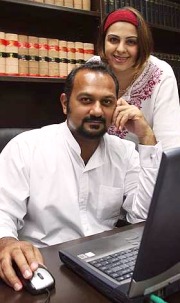
The news came from Pakistan and Malaysia.
In Pakistan, it seems a section of the Sikh community there has demanded
”The Sikhs’ problems could be solved if the community is given representation in the government or if a Sikh is appointed an adviser to the prime minister,” said Swaran Singh, candidate for the post of president of the Pakistan Sikh Gurdwara Prabandhak Committee.
He suggested that an adviser to the prime minister should be appointed to attract Sikhs from other countries to invest in Pakistan. Christians and Hindus have representations in the government, but Sikhs have yet to reach the national or provincial assemblies, he said. [link]
In Malaysia, the news rang out:
Malaysian ethnic Punjabi Karpal Singh and son Gobind Singh Deo have created history by becoming the first-ever father-son duo to be elected members of a Parliament in the world. [link]
We know the Britney Spears and Miley Rays of Hollywood tremendously influence the lives of our pre-teen and adolescent girls. The voices we keep hearing on television are those of white, multi-generational American, and suburban teens.

Their experiences are being boxed and represented as THE experience of adolescent girls in America. Rarely on television does the media interview pre-teen and teen girls of color from immigrant backgrounds living in urban/rural areas about their perceptions of life and the future – unless the story is on teen pathology from pregnancy to drugs and violence.
Therefore, I was pleased to see the trailer of a documentary, “Going on 13”, that is about pre-teen girls from minority, immigrant, and urban backgrounds discussing how they negotiate the whirlwind of changes and choices, from body image to relationships, just as girls in the suburbs.

The only distinction is how their social, economic, and cultural contexts add a different layer to the experience that is not a form of “mal-adaptation”, but another way of living. The film-makers’ goal was “… to show the reality of preteen girls and urban minorities, which isn’t often portrayed in the mainstream media” and “… wasn’t just focused on the pathology of urban youth”.
While we’ve heard a recurrent Canadian voice that claims that Sikhi is incompatible with being openly LGBTIQ, a new Sikh-specific support group has grown in Vancouver. There have certainly been South Asian-specific support organizations in the diaspora for the last decade or so (within the U.S., Trikone in SF, and SALGA on the east coast). However, these organizations have been challenged to create space for those at the intersections of regional and religious identity — i.e., between a Punjabi/South Asian ethnic identity and a Sikh religious identity. Similar organizations have recently sprouted up in the queer (South Asian) Muslim community, but this is the first formal Sikh support group I’ve heard about.
This made me reflect on other issues of integration and advocacy across communities. I think it’s vitally important to have community organizations, in part because they play a large role in creating sustainable institutions. However, I also resent that “mainstream” organizations sometimes use these institutions as an excuse for failing to provide comprehensive services for the true diversity within a larger, umbrella community. I also worry that it’s only possible to get this level of specificity in areas where there is a large enough community to achieve a critical mass.
What do you think, readers? Would a Sher in your area provide a necessary safe space? Would it be feasible?
Previous coverage: Towards a Queer ethos, A “Sensible” Religious Response to LGBTIQ Sikhs
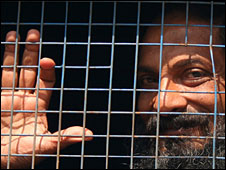 for Civil Liberties
for Civil Liberties
